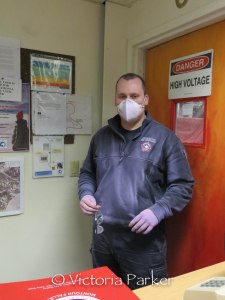Where there is an airport, there be ARFF, matey…
Yaarrrrr… Okay, I’m past the whole pirate thing.












So, one of the main reasons that the Antarctic Fire Department has a permanent station at McMurdo, a temporary station at the airfield (depends on the season and which airfield is operational – Pegasus or the seasonal (temperamental) ice runway – as well as the South Pole station (also seasonal), is to provide ARFF services. ARFF stands for Aircraft Rescue and Firefighting. ARFF certified firefighters have gone through special courses, and they continue to train yearly, in order to become the best at handling aircraft emergencies.
From (yes I know I love it) Wikipedia –
Aircraft rescue and firefighting (ARFF) is a special category of firefighting that involves the response, hazard mitigation, evacuation and possible rescue of passengers and crew of an aircraft involved in (typically) an airport ground emergency.
Airports may have regulatory oversight by an arm of their individual national governments or voluntarily under standards of the International Civil Aviation Organization.
Due to the mass casualty potential of an aviation emergency, the speed with which emergency response equipment and personnel arrive at the scene of the emergency is of paramount importance. Their arrival and initial mission to secure the aircraft against all hazards, particularly fire, increases the survivability of the passengers and crew on board. Airport firefighters have advanced training in the application of firefighting foams, dry chemical and clean agents used to extinguish burning aviation fuelin and around an aircraft in order to maintain a path for evacuating passengers to exit the fire hazard area. Further, should fire either be encountered in the cabin or extend there from an external fire, the ARFF responders must work to control/extinguish these fires as well.
But Tori, what does purple stuff have to do with this?
Well, I’ll tell you. Purple stuff – AKA Purple K, and PKP – is a dry-chemical fire suppression agent used in some dry powder fire extinguishers. (yep, Wikipedia) It also –
Purple-K powder has an acrid taste and odor, is free-flowing, floating on most liquids, non-abrasive, does not wet with water and is compatible with most foam concentrates. It has violet color, to distinguish it from other dry agents. Its principal component is potassium bicarbonate (78–82% by weight), with addition of sodium bicarbonate (12–15%), mica (1–3%), Fuller’s earth (1–3%), amorphous silica (0.2–%), and is made hydrophobic bymethyl hydrogen polysiloxane (0.2–1%).
Purple-K is normally non-toxic, but ingestion of large amount can cause alkalosis. In high temperatures it decomposes to carbon dioxide andpotassium oxide, which is toxic and highly corrosive. (Wikipedia again)
But why am I talking about it? Okay, last Wiki reference –
Purple-K is commonly used in oil refineries, airport ramps, service stations, military facilities, naval warships, power plants, and other places where flammable liquids are handled. It is often paired with foam in twin agent systems, usually found fitted to airport fire appliances.
Purple-K is used in many forms, from small handheld fire extinguishers to large mobile and stationary units, including fixed-nozzle piping systems.
Cleanup of spent agent can be difficult, as it creates a mess when discharged. If the spent agent is dry it can be removed by suction, but when combined with water, hydrocarbons and other liquids, it forms a thick crusty scum that can be challenging to remove.
Hrm… Why am I writing about it. Well! I’ll tell you!!!
The last portion that I referenced, you know, the part about the spent agent being a mess when discharged… Well, heh, we have purple stuff in the bay. And I have pictures and videos of the discharging process of dry chem and photos of the mess it leaves all over the place.
Enjoy!
Stay safe and purple free!
Im doing an assignment but I want to know “why is purple k the only dry chemical used in aircraft rescue and firefighting?”
Please reach out or otherwise get in contact